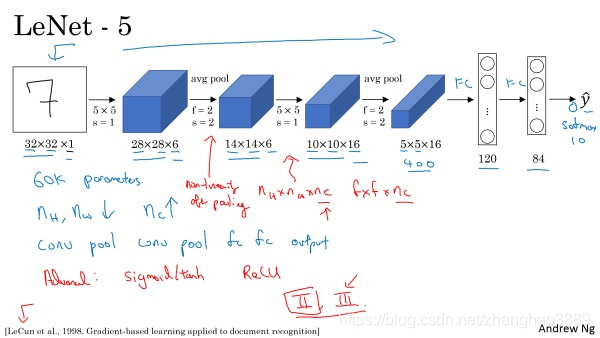本章所需知识:
- 没有基础的请观看深度学习系列视频
- tensorflow
恩达老师的可视化极强的网络结构图:

接着加上我自己使用Tensorflow实现的代码:
LeNet_5网络
import tensorflow as tf
import tensorflow.examples.tutorials.mnist.input_data as input_data
mnist = input_data.read_data_sets("MNIST_data/", one_hot=True) # 导入数据集
'''LeNet_5, 可以识别图片中的手写数字, 针对灰度图像训练的'''
class LeNet_5:
def __init__(self):
self.in_x = tf.placeholder(dtype=tf.float32, shape=[None, 28, 28, 1], name="in_x")
self.in_y = tf.placeholder(dtype=tf.float32, shape=[None, 10], name="in_y")
# 卷积层 (batch, 28, 28, 1) -> (batch, 24, 24, 6)
self.conv1 = tf.layers.Conv2D(filters=6, kernel_size=5, strides=(1, 1),
kernel_initializer=tf.truncated_normal_initializer(stddev=tf.sqrt(1 / 6)))
# 池化层 (batch, 24, 24, 6) -> (batch, 12, 12, 6)
self.pool1 = tf.layers.AveragePooling2D(pool_size=(2, 2), strides=(2, 2))
# 卷积层 (batch, 12, 12, 6) -> (batch, 8, 8, 16)
self.conv2 = tf.layers.Conv2D(filters=16, kernel_size=5, strides=(1, 1),
kernel_initializer=tf.truncated_normal_initializer(stddev=tf.sqrt(1 / 16)))
# 池化层 (batch, 8, 8, 16) -> (batch, 4, 4, 16)
self.pool2 = tf.layers.AveragePooling2D(pool_size=(2, 2), strides=(2, 2))
# 全链接层 (batch, 4*4*16(256)) -> (batch, 120)
self.fc1 = tf.layers.Dense(120, kernel_initializer=tf.truncated_normal_initializer(stddev=tf.sqrt(1 / 120)))
# 全链接层 (batch, 120) -> (batch, 10)
self.fc2 = tf.layers.Dense(10, kernel_initializer=tf.truncated_normal_initializer(stddev=tf.sqrt(1 / 10)))
def forward(self): # 因为是还原LeNet5 所以使用sigmoid
self.conv1_out = tf.nn.sigmoid(self.conv1(self.in_x)) # 将图片传入 conv1
self.pool1_out = self.pool1(self.conv1_out) # 将 conv1 的输出传入 pool1
self.conv2_out = tf.nn.sigmoid(self.conv2(self.pool1_out)) # 将 pool1 的输出传入 conv2
self.pool2_out = self.pool2(self.conv2_out) # 将 conv2 的输出传入 pool2
self.flat = tf.reshape(self.pool2_out, shape=[-1, 256]) # 将 pool2 的输出reshape成 (batch, -1(-1指这里的256,具体看计算出的图大小))
self.fc1_out = tf.nn.sigmoid(self.fc1(self.flat)) # 将 reshape 后的图传入 fc1
self.fc2_out = tf.nn.softmax(self.fc2(self.fc1_out)) # 将 fc1 的输出传入 fc2
def backward(self): # 后向计算
self.loss = tf.reduce_mean((self.fc2_out - self.in_y) ** 2) # 均方差计算损失
self.opt = tf.train.AdamOptimizer().minimize(self.loss) # 使用Adam优化器优化损失
def acc(self): # 精度计算(可不写, 不影响网络使用)
self.acc1 = tf.equal(tf.argmax(self.fc2_out, 1), tf.argmax(self.in_y, 1))
self.accaracy = tf.reduce_mean(tf.cast(self.acc1, dtype=tf.float32))
if __name__ == '__main__':
net = LeNet_5() # 创建LeNet_5的对象
net.forward() # 执行前向计算
net.backward() # 执行后向计算
net.acc() # 执行精度计算
init = tf.global_variables_initializer() # 初始化所有tensorflow变量
with tf.Session() as sess:
sess.run(init)
for i in range(10000):
train_x, train_y = mnist.train.next_batch(100) # 取出mnist训练集的 100 批数据和标签
train_x_flat = train_x.reshape([-1, 28, 28, 1]) # 将数据整型
# 将数据传入网络,并得到计算后的精度和损失
acc, loss, _ = sess.run(fetches=[net.accaracy, net.loss, net.opt],
feed_dict={net.in_x: train_x_flat, net.in_y: train_y})
if i % 100 == 0: # 每训练100次打印一次训练集精度和损失
print("训练集精度:|", acc)
print("训练集损失:|", loss)
test_x, test_y = mnist.test.next_batch(100) # 取出100批测试集数据进行测试
test_x_flat = test_x.reshape([-1, 28, 28, 1]) # 同上
# 同上
test_acc, test_loss = sess.run(fetches=[net.accaracy, net.loss],
feed_dict={net.in_x: test_x_flat, net.in_y: test_y})
print('----------')
print("验证集精度:|", test_acc) # 打印验证集精度
print("验证集损失:|", test_loss) # 打印验证集损失
print('--------------------')
最后附上训练截图:

来源:https://www.cnblogs.com/Mrzhang3389/p/9977632.html